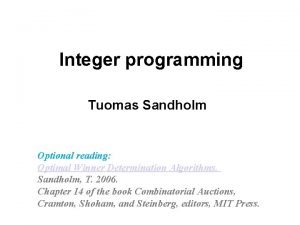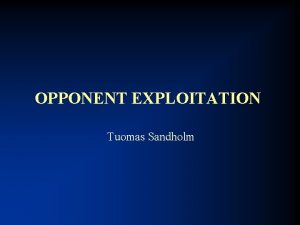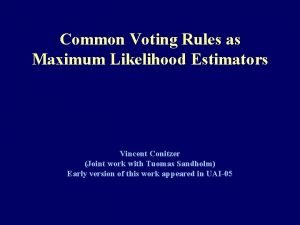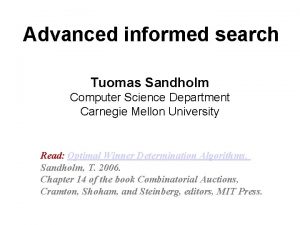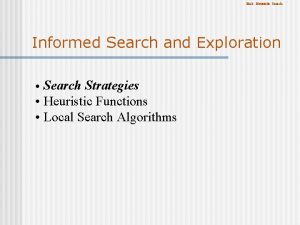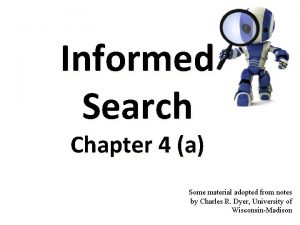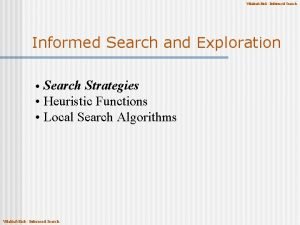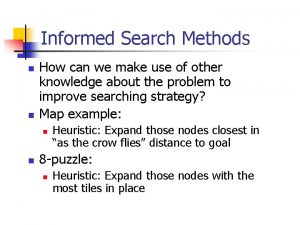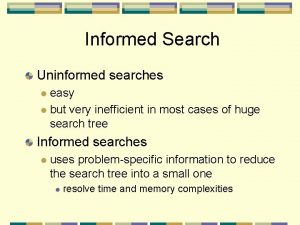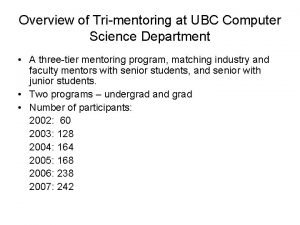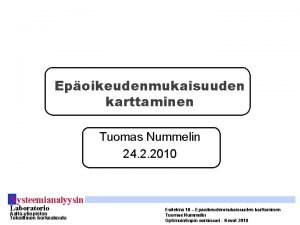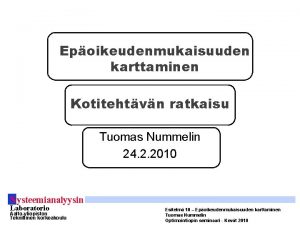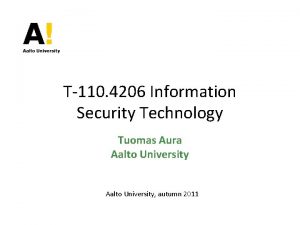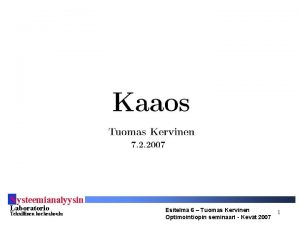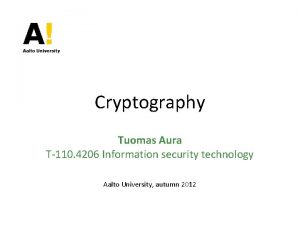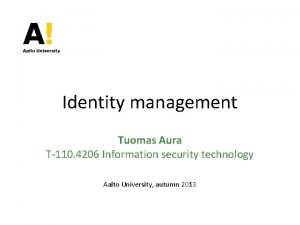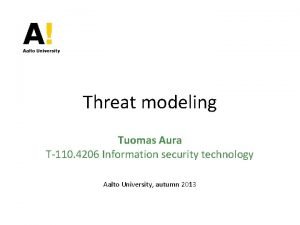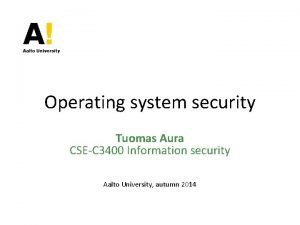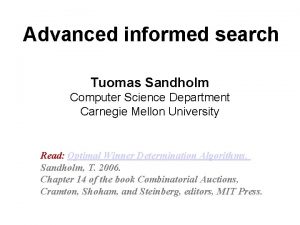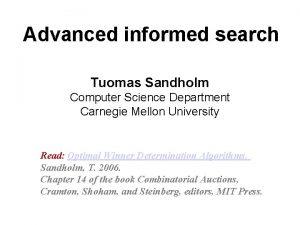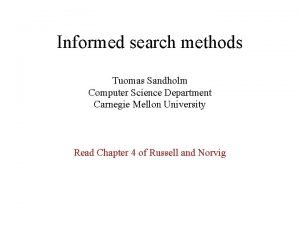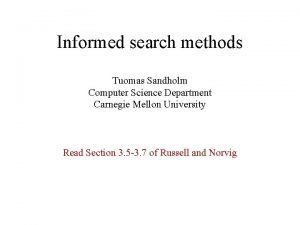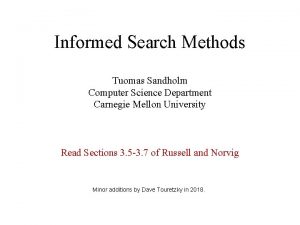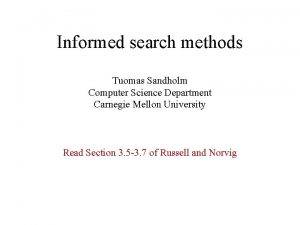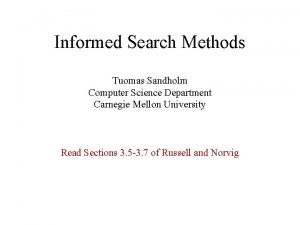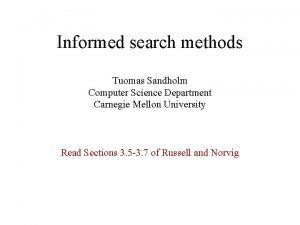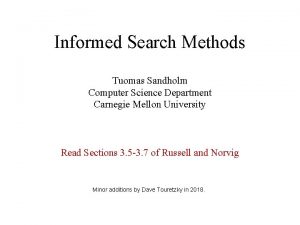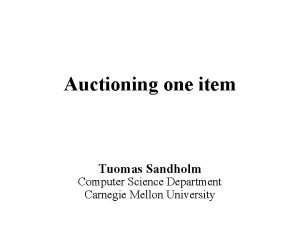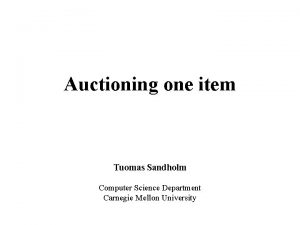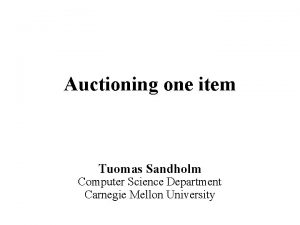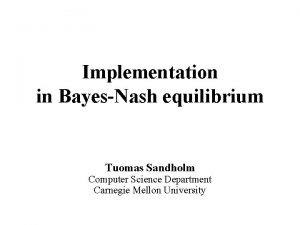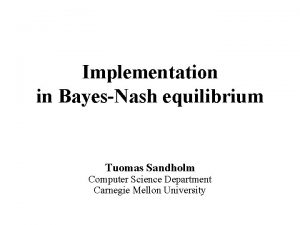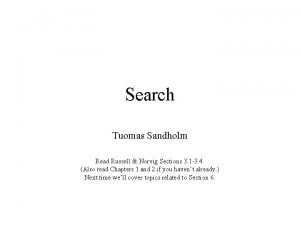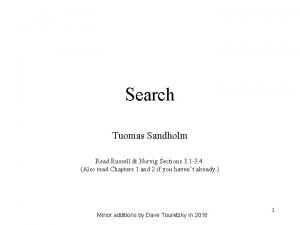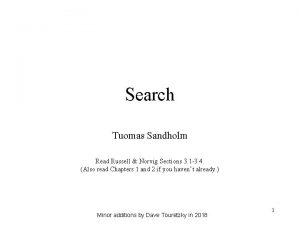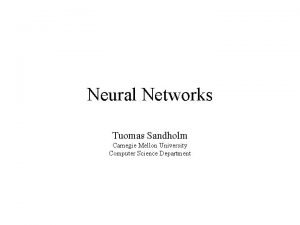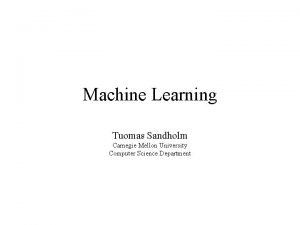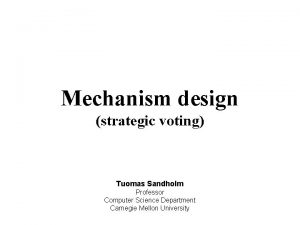Advanced informed search Tuomas Sandholm Computer Science Department



![Auction design for multi-item settings… • Combinatorial auctions [Rassenti, Smith&Bulfin 82]. . . – Auction design for multi-item settings… • Combinatorial auctions [Rassenti, Smith&Bulfin 82]. . . –](https://slidetodoc.com/presentation_image_h2/9341314e1a409129aa5aa4e976823193/image-4.jpg)

![NP-completeness • NP-complete [Rothkopf et al Mgmt Sci 98] – Weighted set packing [Karp NP-completeness • NP-complete [Rothkopf et al Mgmt Sci 98] – Weighted set packing [Karp](https://slidetodoc.com/presentation_image_h2/9341314e1a409129aa5aa4e976823193/image-6.jpg)



![First generation search algorithms: branch-on-items formulation [Sandholm ICE-98, IJCAI-99, AIJ-02] Bids: 1 2 1, First generation search algorithms: branch-on-items formulation [Sandholm ICE-98, IJCAI-99, AIJ-02] Bids: 1 2 1,](https://slidetodoc.com/presentation_image_h2/9341314e1a409129aa5aa4e976823193/image-10.jpg)
![2 nd generation algorithm: Combinatorial Auction, Branch On Bids [Sandholm&Suri AAAI-00, AIJ-03] Bids of 2 nd generation algorithm: Combinatorial Auction, Branch On Bids [Sandholm&Suri AAAI-00, AIJ-03] Bids of](https://slidetodoc.com/presentation_image_h2/9341314e1a409129aa5aa4e976823193/image-11.jpg)



















![Branching on more general questions than individual variables [Gilpin&Sandholm 03, IJCAI-07] • • • Branching on more general questions than individual variables [Gilpin&Sandholm 03, IJCAI-07] • • •](https://slidetodoc.com/presentation_image_h2/9341314e1a409129aa5aa4e976823193/image-31.jpg)


![Example 1: “Short” bids [Sandholm&Suri AAAI-00, AIJ-03] • Never branch on short bids with Example 1: “Short” bids [Sandholm&Suri AAAI-00, AIJ-03] • Never branch on short bids with](https://slidetodoc.com/presentation_image_h2/9341314e1a409129aa5aa4e976823193/image-34.jpg)

![Example 3: [Sandholm & Suri AAAI-00, AIJ-03] Example 3: [Sandholm & Suri AAAI-00, AIJ-03]](https://slidetodoc.com/presentation_image_h2/9341314e1a409129aa5aa4e976823193/image-36.jpg)
![Example 3. . . • Thrm. [Conitzer, Derryberry & Sandholm AAAI-04] An item tree Example 3. . . • Thrm. [Conitzer, Derryberry & Sandholm AAAI-04] An item tree](https://slidetodoc.com/presentation_image_h2/9341314e1a409129aa5aa4e976823193/image-37.jpg)
![Generalization: substitutability [Sandholm IJCAI-99, AIJ-02] • What if agent 1 bids – $7 for Generalization: substitutability [Sandholm IJCAI-99, AIJ-02] • What if agent 1 bids – $7 for](https://slidetodoc.com/presentation_image_h2/9341314e1a409129aa5aa4e976823193/image-38.jpg)
- Slides: 38

Advanced informed search Tuomas Sandholm Computer Science Department Carnegie Mellon University Read: Optimal Winner Determination Algorithms. Sandholm, T. 2006. Chapter 14 of the book Combinatorial Auctions, Cramton, Shoham, and Steinberg, editors, MIT Press.

Example application: Winner determination in multi-item auctions • • Auctioning multiple distinguishable items when bidders have preferences over combinations of items: complementarity & substitutability Example applications – Allocation of transportation tasks – Allocation of bandwidth • Dynamically in computer networks • Statically e. g. by FCC – – – – Sourcing Electricity markets Securities markets Liquidation Reinsurance markets Retail ecommerce: collectibles, flights-hotels-event tickets Resource & task allocation in operating systems & mobile agent platforms

Auction design for multi-item settings • Sequential auctions – How should rational agents bid (in equilibrium)? • Full vs. partial vs. no lookahead • Would need normative deliberation control methods – Inefficiencies can result from future uncertainties • Parallel auctions – Inefficiencies can still result from future uncertainties – Postponing & minimum participation requirements • Unclear what equilibrium strategies would be • Methods to tackle the inefficiencies – Backtracking via reauctioning (e. g. FCC [Mc. Afee&Mc. Millan 96]) – Backtracking via leveled commitment contracts [Sandholm&Lesser 95, AAAI-96, GEB-01] [Sandholm 96] [Andersson&Sandholm 98 a, b] • Breach before allocation • Breach after allocation
![Auction design for multiitem settings Combinatorial auctions Rassenti SmithBulfin 82 Auction design for multi-item settings… • Combinatorial auctions [Rassenti, Smith&Bulfin 82]. . . –](https://slidetodoc.com/presentation_image_h2/9341314e1a409129aa5aa4e976823193/image-4.jpg)
Auction design for multi-item settings… • Combinatorial auctions [Rassenti, Smith&Bulfin 82]. . . – Bids can be submitted on combinations (bundles) of items – Bidder’s perspective • Avoids the need for lookahead • (Potentially 2#items valuation calculations) – Auctioneer’s perspective: • Automated optimal bundling of items • Winner determination problem: – Label bids as winning or losing so as to maximize sum of bid prices (= revenue social welfare) – Each item can be allocated to at most one bid • Exhaustive enumeration is 2#bids

![NPcompleteness NPcomplete Rothkopf et al Mgmt Sci 98 Weighted set packing Karp NP-completeness • NP-complete [Rothkopf et al Mgmt Sci 98] – Weighted set packing [Karp](https://slidetodoc.com/presentation_image_h2/9341314e1a409129aa5aa4e976823193/image-6.jpg)
NP-completeness • NP-complete [Rothkopf et al Mgmt Sci 98] – Weighted set packing [Karp 72]

Polynomial time approximation algorithms with worst case guarantees value of optimal allocation k= value of best allocation found General case • Cannot be approximated to k = #bids 1 - (unless probabilistic polytime = NP) – Proven in [Sandholm IJCAI-99, AIJ-02] – Reduction from MAXCLIQUE, which is inapproximable [Håstad 96] • Best known approximation gives k O(#bids / (log #bids)2 ) [Haldorsson 98]

Polynomial time approximation algorithms with worst case guarantees Special cases • Let be the max #items in a bid: k= 2 / 3 [Haldorsson SODA-98] • Bid can overlap with at most other bids: k= min( ( +1) / 3 , ( +2) / 3, / 2 ) [Haldorsson&Lau 97; Hochbaum 83] • k= sqrt(#items) [Haldorsson 99] • k= chromatic number / 2 [Hochbaum 83] – k=[1 + max. H G minv H degree(v) ] / 2 [Hochbaum 83] – Planar: k=2 [Hochbaum 83] • So far from optimum that irrelevant for auctions • Probabilistic algorithms? • New special cases, e. g. based on prices [Lehmann et al. 01, …]

Solving the winner determination problem when all combinations can be bid on: Search algorithms for optimal anytime winner determination • • Capitalize on sparsely populated space of bids Generate only populated parts of space of allocations Highly optimized 1 st generation algorithm: branch-on-items formulation [Sandholm ICE-98, IJCAI-99, AIJ-02; Fujishima, Leyton-Brown & Shoham IJCAI 99] • 2 nd generation algorithm: branch-on-bids formulation [Sandholm&Suri AAAI-00, AIJ-03, Sandholm et al. IJCAI-01, Mgmt. Sci-05] • New ideas, e. g. , multivariate branching [Gilpin & Sandholm IJCAI 07, …]
![First generation search algorithms branchonitems formulation Sandholm ICE98 IJCAI99 AIJ02 Bids 1 2 1 First generation search algorithms: branch-on-items formulation [Sandholm ICE-98, IJCAI-99, AIJ-02] Bids: 1 2 1,](https://slidetodoc.com/presentation_image_h2/9341314e1a409129aa5aa4e976823193/image-10.jpg)
First generation search algorithms: branch-on-items formulation [Sandholm ICE-98, IJCAI-99, AIJ-02] Bids: 1 2 1, 2 3 4 5 3, 5 3 1, 2 1, 3, 5 1, 4 4 4 2, 5 3, 5 5 1, 3, 5 2 4 1 1, 4 2, 5 3 2 2, 5 3 5 3 4 2 3, 5 3 4 Prop. Need only consider children that include item with smallest index among items not on the path Insert dummy bid for price 0 for each single item that has no bids => allows bid combinations that do not cover all items (seller can keep some items) Generates each allocation of positive value once, others not generated Complexity – Prop. #leaves ≤ (#bids/#items)#items – Proof. Let ni be the number of bids that include item i but no items with smaller index. #leaves ≤ max n 1 ∙ n 2 ∙ … ∙ nm s. t. n 1 + n 2 + …+ nm = #bids. Max achieved at ni = n/m. Depth at most m. QED – #nodes ≤ #items #leaves – IDA* is 2 orders of magnitude faster than depth first search – Anytime algorithm 4 5
![2 nd generation algorithm Combinatorial Auction Branch On Bids SandholmSuri AAAI00 AIJ03 Bids of 2 nd generation algorithm: Combinatorial Auction, Branch On Bids [Sandholm&Suri AAAI-00, AIJ-03] Bids of](https://slidetodoc.com/presentation_image_h2/9341314e1a409129aa5aa4e976823193/image-11.jpg)
2 nd generation algorithm: Combinatorial Auction, Branch On Bids [Sandholm&Suri AAAI-00, AIJ-03] Bids of this example A={1, 2} B={2, 3} C={3} D={1, 3} C IN A IN B A D C OUT Bid graph B IN B D C OUT C • • Finds an optimal solution Naïve analysis: 2#bids leaves • Thrm. At most IN D C OUT D leaves – where k is the minimum #items per bid – provably polynomial in bids even in worst case! IN D OUT

Use of h-values (=upper bounds) to prune winner determination search • f* = value of best solution found so far • g = sum of prices of bids that are IN on path • h = value of LP relaxation of remaining problem • Upper bounding: Prune the path when g+h ≤ f*

Linear programming for computing h-values

Linear program of the winner determination problem aka shadow price

Linear programming Original problem Initial tableau maximize such that Slack variables Assume, for simplicity, that origin is feasible (otherwise have to run a different LP to find first feasible and run the main LP in a revised space). Simplex method “pivots” variables in and out of the tableau Basic variables are on the left hand side

Graphical interpretation of simplex algorithm for linear programming Entering x 2 variable x 1 Departing variable is slack variable of the constraint Departing variable Constraints c Feasible region Entering variable x 2 Each pivot results in a new tableau x 1 Interior point methods are another family of algorithms for linear programming

Speeding up the use of linear programs in search • If LP returns a solution where all integer variables have integer values, then that is the solution to that node and no further search is needed below that node • Instead of simplex in the LP, use simplex in the DUAL because after branching, the previous DUAL solution is still feasible and a good starting point for simplex at the new node (see next slide) – Thrm. LP optimum value = DUAL optimum value aka shadow price

Example showing DUAL is feasible at children Goods: {1, 2, 3}, Bids: <{1, 2}, $4>, <{1, 3}, $3>, <{2, 3}, $2> LP LP Infeasible (x 2 > 0) DUAL Feasible (for any y 4) LP Infeasible (x 2 < 1) DUAL Feasible (for y 4 = 0)

The branch-and-cut approach

Cutting planes (aka cuts) • Extra linear constraints can be added to the LP to reduce the LP polytope and thus give tighter bounds (less optimistic h-values) if the constraints are guaranteed to not exclude any integer solutions • Applications-specific vs. general-purpose cuts • Branch-and-cut algorithm = branch-and-bound algorithm that uses cuts – A global cut is valid throughout the search tree – A local cut is guaranteed to be valid only in the subtree below the node at which it was generated (and thus needs to be removed from consideration when not in that subtree)

Example of a cut that is valid for winner determination: Odd hole inequality E. g. , 5 -hole x 8 x 3 x 2 No chord x 1 x 6 Edge means that bids share items, so both bids cannot be accepted x 1 + x 2 + x 3 + x 6 + x 8 ≤ 2

Separation using cuts LP optimum Valid cut that separates Valid cut that does not separate Invalid cut

How to find cuts that separate? • For some cut families (and/or some problems), there are polynomial-time algorithms for finding a separating cut • Otherwise, use: – Generate a cut • Generation preferably biased towards cuts that are likely to separate – Test whether it separates

Gomory mixed integer cut • Most powerful general-purpose cut for many problems • Applicable to all problems, where – constraints and objective are linear, – the problem has integer variables and potentially also real variables • Cut is generated using the LP optimum so that the cut separates Interesting tidbit (which we will not use here): Gomory’s cutting plane algorithm Integer program can be solved with no search by an algorithm that generates a finite (potentially exponential) number of these cuts. Between the generation of cuts, the (dual) LP is solved. The LP tableau guides which cut is generated next. Rules against cycling in the LP solving are needed to guarantee optimality in a finite number of steps (see, e. g. , http: //www. math. unl. edu/~shartke 2/teaching/2008 f 432/Handout_Gomory. pdf). While this algorithm has been viewed as a mere curiosity, it has very recently shown promise on some practical problems (the anti-cycling rule is key).

Derivation of Gomory mixed integer cut Input: one row from optimal tableau: Fractional, basic, not a slack, integer variable Define: Non-basic. Integer. Continuous. Rewrite tableau row: Idea: RHS above has to be integral. All integer terms add up to integers, so: LHS and RHS differ by an integer

Back to search for winner determination…

Formulation comparison • A branching decision – in the branch-on-bids formulation locks in only one bid (and on the IN branch also its neighbors) – in the branch-on-items formulation locks in all bids that include that item • The former follows the principle of least commitment • More flexibility for further decision ordering (choice of which decision to branch on in light of the newest information)

Structural improvements to search algorithms for winner determination Optimum reached faster & better anytime performance • • • Always branch on a bid j that maximizes e. g. pj / |Sj| (presort) Lower bounding: If g+L>f*, then f* g+L Identify decomposition of bid graph in O(|E|+|V|) time & exploit • – Pruning across subproblems (upper & lower bounding) by using f* values of solved subproblems and h values of yet unsolved ones Forcing decomposition by branching on an articulation bid – All articulation bids can be identified in O(|E|+|V|) time – Could try to identify combinations of bids that articulate (cutsets)


Question ordering heuristics • In depth-first branch-and-bound, it is sometimes best to branch on a question for which the algorithm knows a good answer with high likelihood – Best (to date) heuristics for branching on bids [Sandholm et al. IJCAI-01, Mgmt. Sci-05]: • A: Branch on bid whose LP value is closest to 1 • B: Branch on bid with highest normalized shadow surplus: – Choosing the heuristic dynamically based on remaining subproblem • E. g. use A when LP table density > 0. 25 and B otherwise • In A* search, it is usually best to branch on a question whose right answer the algorithm is very uncertain about – Traditionally in OR, variable whose LP value is most fractional – More general idea [Gilpin&Sandholm 03]: branch on a question that reduces the entropy of the LP solution the most • Determine this e. g. based on lookahead • Applies to multivariate branching too
![Branching on more general questions than individual variables GilpinSandholm 03 IJCAI07 Branching on more general questions than individual variables [Gilpin&Sandholm 03, IJCAI-07] • • •](https://slidetodoc.com/presentation_image_h2/9341314e1a409129aa5aa4e976823193/image-31.jpg)
Branching on more general questions than individual variables [Gilpin&Sandholm 03, IJCAI-07] • • • Branching question: “Of these k bids, are more than x winners? ” Never include bids whose LP values are integers Never use a set of bids whose LP values sum to an integer Prop. Only one sensible cutoff of x Prop. The search space size is the same regardless of which bids (and how many) are selected for branching • Usually yields smaller search trees than branching on individual bids only • More generally in MIP, one branch one can branch on hyperplanes: one branch is ∑i S α i x i ≤ c 1 and the other branch is ∑i S α i x i > c 2 for some S – But how to decide on which hyperplane to branch? – For more on this approach, see, e. g. , Improved Strategies for Branching on General Disjunctions by Gerard Cornuejols, Leo Liberti and Giacomo Nannicini, July 2008

Other good branching rules (for integer programs) • Strong branching (= 1 -step lookahead) – At a node, for each variable (from a set of promising candidate variable) in turn, pretend that you branch on that variable and solve the node’s childrens’ LPs • Sometimes child LPs are not solved to optimality (cap on # of dual pivots) to save time – Pick the variable to branch on that leads to tightest child LP bounds • Sometimes better and worse child are weighted differently • Reliability branching – Like strong branching, but once lookahead for a certain variable has been conducted at a large enough number of nodes, stop doing lookahead for that variable, and use average reduction in bound in past lookaheads for that variable as that variable’s goodness measure • These could be used when branching on hyperplanes too

Identifying & solving tractable cases at search nodes (so that no search is needed below such nodes) [Sandholm & Suri AAAI-00, AIJ-03]
![Example 1 Short bids SandholmSuri AAAI00 AIJ03 Never branch on short bids with Example 1: “Short” bids [Sandholm&Suri AAAI-00, AIJ-03] • Never branch on short bids with](https://slidetodoc.com/presentation_image_h2/9341314e1a409129aa5aa4e976823193/image-34.jpg)
Example 1: “Short” bids [Sandholm&Suri AAAI-00, AIJ-03] • Never branch on short bids with 1 or 2 items – At each search node, we solve short bids from bid graph separately • O(#short bids 3) time using maximal weighted matching – [Edmonds 65; Rothkopf et al 98] • NP-complete even if only 3 items per bid allowed – Dynamically delete items included in only one bid

Example 2: Interval bids • • • At each search node, use a polynomial algorithm if remaining bid graph only contains interval bids – Ordered list of items: 1. . #items – Each bid is for some interval [q, r] of these items – [Rothkopf et al. 98] presented O(#items 2) DP algorithm – [Sandholm&Suri AAAI-00, AIJ-03] DP algorithm is O(#items + #bids) • Bucket sort bids in ascending order of r • opt(i) is the optimal solution using items 1. . i • opt(i) = max b in bids whose last item is i {pb + opt(qb-1), opt(i-1)} Identifying linear ordering – Can be identified in O(|E|+|V|) time [Korte & Mohring SIAM-89] Interval bids with wraparound can be identified in O(#bids 2) time [Spinrad SODA-93] and solved in O(#items + #bids)) time using our DP while DP of Rothkopf et al. is O(#items 3)
![Example 3 Sandholm Suri AAAI00 AIJ03 Example 3: [Sandholm & Suri AAAI-00, AIJ-03]](https://slidetodoc.com/presentation_image_h2/9341314e1a409129aa5aa4e976823193/image-36.jpg)
Example 3: [Sandholm & Suri AAAI-00, AIJ-03]
![Example 3 Thrm Conitzer Derryberry Sandholm AAAI04 An item tree Example 3. . . • Thrm. [Conitzer, Derryberry & Sandholm AAAI-04] An item tree](https://slidetodoc.com/presentation_image_h2/9341314e1a409129aa5aa4e976823193/image-37.jpg)
Example 3. . . • Thrm. [Conitzer, Derryberry & Sandholm AAAI-04] An item tree that matches the remaining bids (if one exists) can be constructed in time O(|Bids| |#items that any one bid contains|2 + |Items|2) • Algorithm: – – Make a graph with the items as vertices Each edge (i, j) gets weight #(bids with both i and j) Construct maximum spanning tree of this graph: O(|Items|2) time Thrm. The resulting tree will have the maximum possible weight #(occurrences of items in bids) - |Bids| iff it is a valid item tree • Complexity of constructing an item graph of treewidth 2 (or 3, or 4, …) is unknown (but complexity of solving any such case given the item graph is “polynomial-time” - exponential only in the treewidth)
![Generalization substitutability Sandholm IJCAI99 AIJ02 What if agent 1 bids 7 for Generalization: substitutability [Sandholm IJCAI-99, AIJ-02] • What if agent 1 bids – $7 for](https://slidetodoc.com/presentation_image_h2/9341314e1a409129aa5aa4e976823193/image-38.jpg)
Generalization: substitutability [Sandholm IJCAI-99, AIJ-02] • What if agent 1 bids – $7 for {1, 2} – $4 for {1} – $5 for {2} ? • Bids joined with XOR – Allows bidders to express general preferences – Groves-Clarke pricing mechanism can be applied to make truthful bidding a dominant strategy – Worst case: Need to bid on all 2#items-1 combinations • OR-of-XORs bids maintain full expressiveness & are more concise – E. g. (B 2 XOR B 3) OR (B 1 XOR B 3 XOR B 4) OR. . . – Our algorithm applies (simply more edges in bid graph => faster) • Preprocessors do not apply • Short bid technique & interval bid technique do not apply
 Työliikekipeytyminen
Työliikekipeytyminen Tuomas sandholm
Tuomas sandholm Tuomas sandholm
Tuomas sandholm Tuomas sandholm
Tuomas sandholm Tuomas sandholm
Tuomas sandholm Tuomas sandholm
Tuomas sandholm Informed search and uninformed search in ai
Informed search and uninformed search in ai Best first search
Best first search Informed (heuristic) search strategies
Informed (heuristic) search strategies Informed search example
Informed search example Blind search
Blind search What is the other name of informed search strategy?
What is the other name of informed search strategy? Informed search
Informed search Greedy search
Greedy search Uninformed and informed search
Uninformed and informed search Advanced topics in computer science
Advanced topics in computer science Bsc computer science ucl
Bsc computer science ucl Northwestern electrical engineering
Northwestern electrical engineering Computer science department rutgers
Computer science department rutgers Meredith hutchin
Meredith hutchin Florida state computer science
Florida state computer science Trimentoring
Trimentoring Department of computer science christ
Department of computer science christ Columbia university department of computer science
Columbia university department of computer science Nina’s favorite subject is science
Nina’s favorite subject is science Tuomas hulkkonen
Tuomas hulkkonen Pihlajalinna killeri
Pihlajalinna killeri Tuomas nummelin
Tuomas nummelin Tuomas nummelin
Tuomas nummelin Tuomas aura
Tuomas aura Tuomas kervinen
Tuomas kervinen Noppa aalto
Noppa aalto Tuomas aitonurmi
Tuomas aitonurmi Tuomas aura
Tuomas aura Tuomas pussila
Tuomas pussila Tuomas partanen
Tuomas partanen Tuomas aura
Tuomas aura Tuomas aura
Tuomas aura Tuomas aura
Tuomas aura


